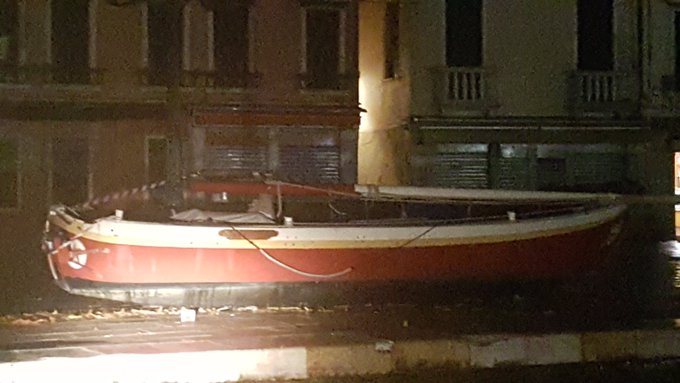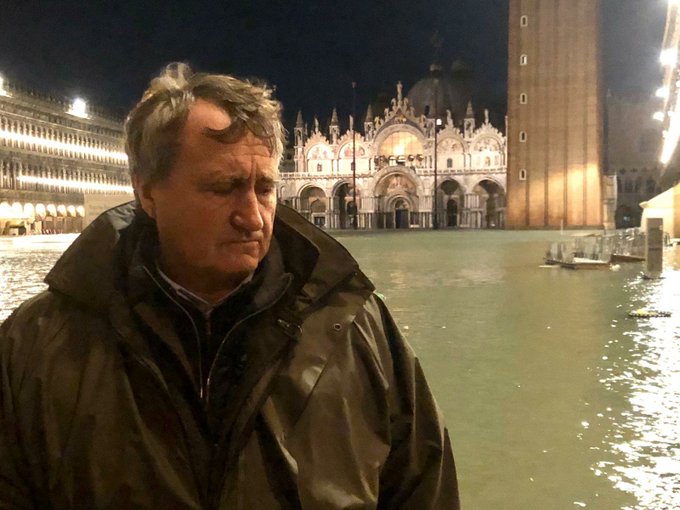
Venice, Italy is suffering from historic flooding that filled St. Mark’s Square with waves and marked the highest tide to hit the irreplaceable city in 50 years. “#Venezia is experiencing one of the longest nights,” the city’s Twitter page said.
On November 12, 2019, the City of Venice wrote on Twitter, “One of the longest nights for #Venezia, with the 187 centimeters touched by the tide. Unfortunately, the damage caused by water and weather violence is evident in part of the city.” One Venice treasure – Saint Mark’s Basilica – flooded for the sixth time in 1,200 years, according to Sky News.
The city continued, “After the tidal peak of 187 centimeters the water fell in the night leaving behind very large damages. The damage count in these hours is continuing. On Wednesday morning another high high water peak is expected.” According to The Guardian, the tide reached 6 feet.
The city shared these photos:
“Citizens are invited to document the damages suffered, the Administration will present a request for a state of crisis to the Region,” the city continued, urging citizens and business to document damages.
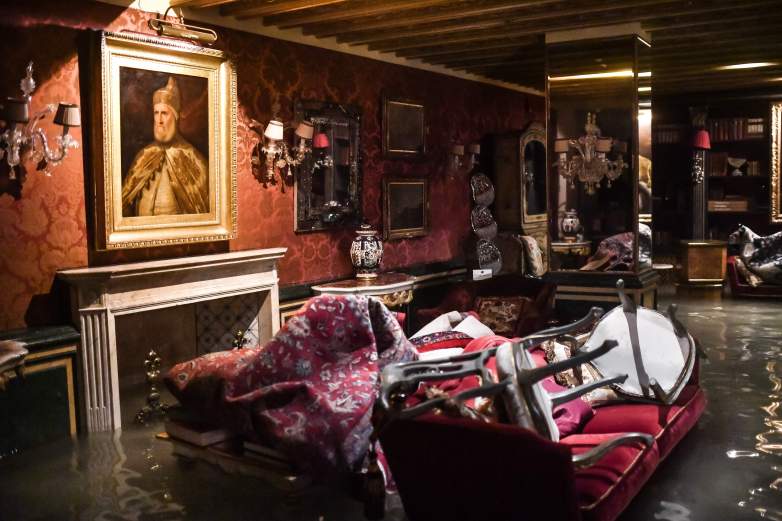
A room in the flooded Gritti Palace is pictured during an exceptional “Alta Acqua” high tide water level on November 12, 2019 in Venice.
It’s called “acqua alta,” a term for flooding that means “high water.” According to Europe for Visitors, flooding “is a fact of life in Venice” that takes place when unusually high tides push water “from the Adriatic Sea into the Venetian Lagoon.” The site says the weather phenomenon is triggered by “low atmospheric pressure and southerly winds.”
In the past, acqua alta only took place two times a year: late fall and early spring. According to Europe for Venice, the flooding can now happen at any time, which it attributed to “ocean levels rising.”

A shop owner clears his flooded premises during an exceptional “Alta Acqua” high tide water level on November 12, 2019 in Venice.
It’s generally believed that the flooding is getting worse over the years. “From 1966 to 2007 high waters of + 110 cm on the mareographic zero occurred only 4 times a year, covering 11% of the town,” explained Turismo Venezia.
The site explains that “Venice and Venetians have always been used to coping with ‘acqua alta.’ These are the City Administration’s measures in case of high tide: if there’s a sea level forecast of +110 cm on the mareographic zero, the population is alerted by acoustic signals and with text messages (for those registered at the free high tide information service of the City Tide Centre – Centro Maree Comunale).”
At the same time, “elevated platforms are set along the main streets to allow passage. Public waterbuses keep on working, although some lines may be subject to changes. In any case access to most of the town is guaranteed. Only when exceptional high waters occur (higher than 120 cm on the mareographic zero) the famous ‘acqua alta boots’ are really needed, but even on these occasions the inconvenience last just as long as it takes for the water to go down again, which usually happens in a few hours.”
The city wrote that “52 civil protection volunteers. They are working together with local police, law enforcement, firefighters and Suem 118.”
A state of emergency was requested.
Although the flooding is unusually severe, it did reach a higher mark in 1966, according to Guardian. On November 12, 2019, water taxis couldn’t get through some areas, and tables and chairs floated in the water, Guardian reported.
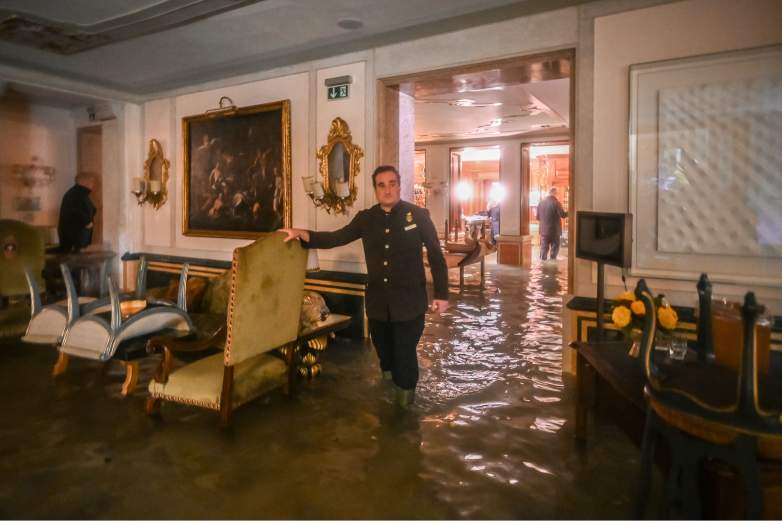
A room in the flooded Gritti Palace is pictured during an exceptional “Alta Acqua” high tide water level on November 12, 2019 in Venice.
According to Sky News, although Venice has always been prone to flooding, the flooding has gotten worse in recent years. Four of the times Saint Mark’s Basilica has flooded came in the last two decades, the site reported.
The British news site also reported that the flooding in famed St. Mark’s Square exceeded three feet.
Luigi Brugnaro, the mayor of Venice, wrote on Twitter (in Italian): “It will be a long night. The high water starts to go down. The fear of a few hours ago now leaves room for the first damage count. A tide at 187 cm is a wound that leaves indelible marks. Now the government must listen.”
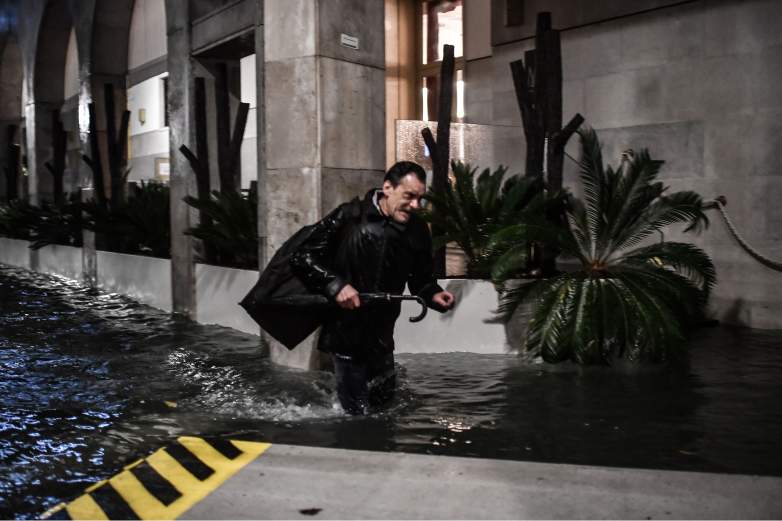
A man crosses a flooded street during an exceptional “Alta Acqua” high tide water level on November 12, 2019 in Venice.
The mayor blamed climate change on his Twitter page. “Tomorrow we will declare a state of calamity. We ask the #Governo to help us, the costs will be high. These are the effects of climate change. …Tomorrow schools closed in Venice and islands.”
On November 12, the city wrote, “UPDATE The Tide Center announces that a possible peak between 140 and 145 centimeters is expected tonight, at 11.00 p.m.”
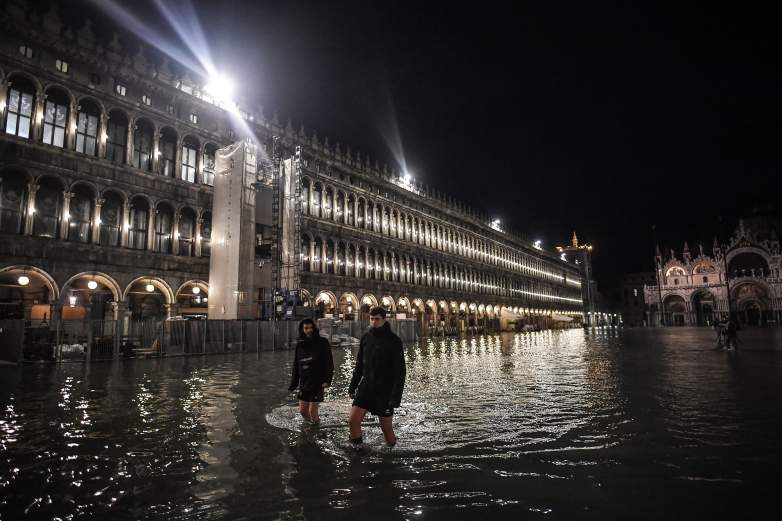
People walk across the flooded Piazza San Marco square during an exceptional “Alta Acqua” high tide water level on November 12, 2019 in Venice.
According to Express, the famed basilica last flooded in 2018. At that time, its administrator said the flood waters aged it 20 years.
“High water depends on the tide cycle (the alternation of high and low tides happens every 6 hours): when there is ‘acqua alta’ on the streets this lasts only a few hours during the peak of the high tide (usually 3 to 4 hours),” Turismo Venezia’s High Water Information Centre wrote. “Once water goes down again, things go back to normality.”

Rescuers patrol across flooded St. Mark’s square past St. Mark’s Basilica during an exceptional “Alta Acqua” high tide water level late on November 12, 2019 in Venice.
The mayor tweeted that the hide tide was “exceptionally” high. “We’re currently facing an exceptionally high tide. Everyone has been mobilized to cope with the emergency,” he wrote.”
According to Turismo Venezia, “High waters may occur in autumn or winter seasons and are most likely to happen in November and December. But even in these months, high waters usually affect only the lowest parts of the town, such as St. Mark’s Square, whereas exceptional high tides statistically occur only once every 5 years.”
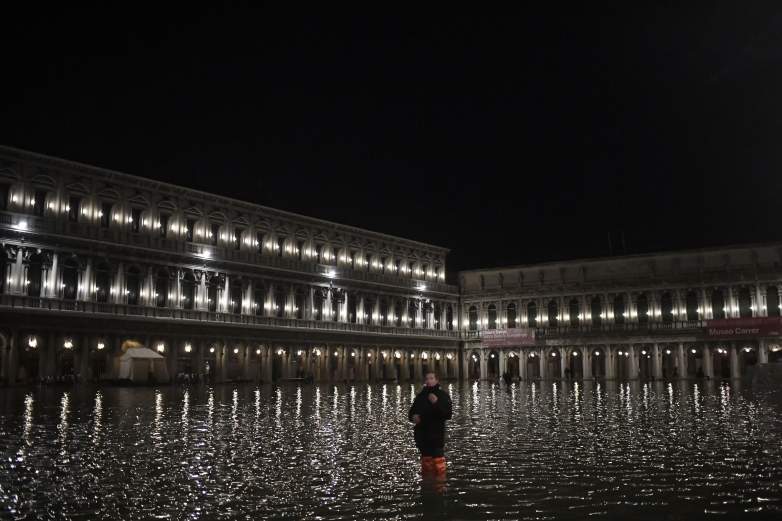
A person walks across flooded St. Mark’s square during an exceptional “Alta Acqua” high tide water level late on November 12, 2019 in Venice.
Al-Jazeera reported that an elderly man died from electrocution when the flood water entered his home. Photos on Getty images and social media showed some buildings flooded inside.
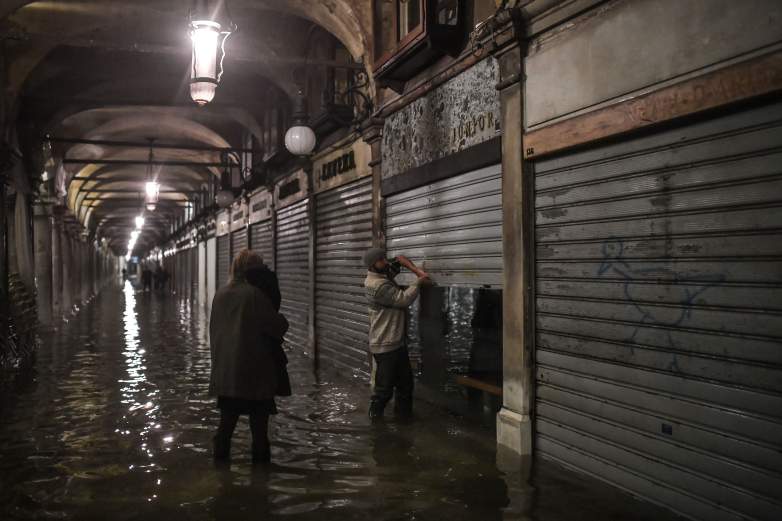
A man closes a shop’s rolling shutter in a flooded arcade during an exceptional “Alta Acqua” high tide water level late on November 12, 2019 in Venice.
Deutsche Welle reported that more bad weather is forecast for Venice.
The Visit Venice site explained of the worst flood, “November 1966: Imagine Venice immersed at 100% by two metres of water!”
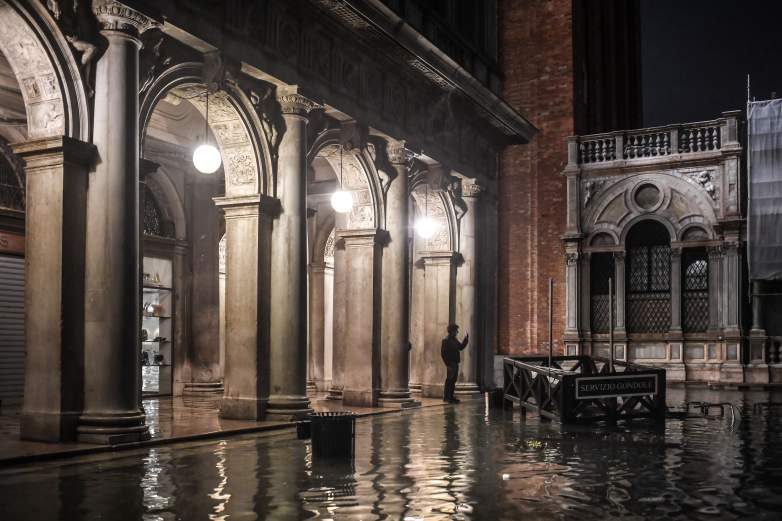
A man stands by a flooded square during an exceptional “Alta Acqua” high tide water level late on November 12, 2019 in Venice.
In a post on historic Venice flooding, Visit Venice quoted Lord Byron:
Oh Venice! Venice! when thy marble walls
Are level with the waters, there shall be
A cry of nations o’er thy sunken halls,
A loud lament along the sweeping sea!
If I, a northern wanderer, weep for thee »
According to Forbes, the city is used to flooding, just not of this magnitude, and has already been working on a flood gate system to prevent it in the future.
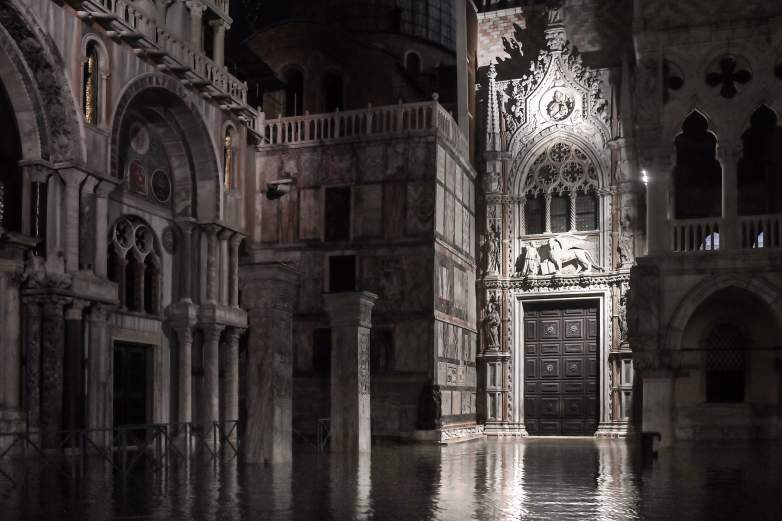
St. Mark’s Basilica (L and C) and a part of the Doge’s Palace (R) are pictured on the flooded St. Marks’ Square.
Explaining Acqua Alta, Visit Venice wrote, “Acqua Alta occurs when certain events coincide; the high tide forms an alliance with low pressures and that their windy friend, Sirocco, participates with our friend the Moon.”
Turismo Venezia explained that “only exceptional high waters affect the whole town and even on those occasions the water-line is really remarkable only in the lowest areas.” Generally, flooding strikes areas like St. Mark’s Square, which are the “lowest parts of the town.”
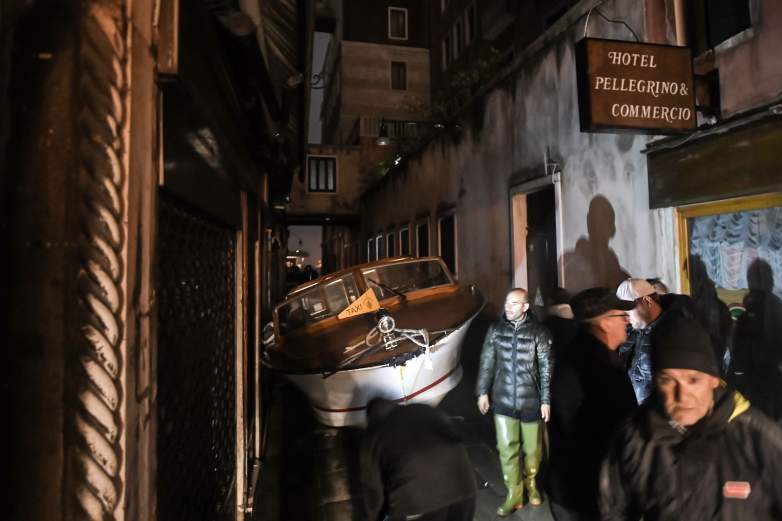
A stranded taxi boat is pictured in an alleyway during an exceptional “Alta Acqua” high tide water level late on November 12, 2019 in Venice.
The first floods were reported in Venice in 782 AD, according to Fodors, which describes Venetian flooding as “a combination of tide and rain, which fill up the lagoon with water, and sirocco winds, blowing northwards from the Adriatic sea against the lagoon’s outlets and preventing the water from flowing back into the sea.”
The fact that Venice is sinking (12 centimeters in 100 years) doesn’t help, according to the site.

A person walks past a stranded taxi boat detached from its mooring and pushed over an embankment during an exceptional “Alta Acqua” high tide water level late on November 12, 2019 in Venice.
The High Water Information Centre for Turismo Venezia explains, “Acqua alta (high water) is a phenomenon which generally takes place in Venice in winter time, when a combination of astronomical tide, strong south wind (scirocco) and seiche…can cause a larger inflow of water into the Venetian Lagoon.”

Gondolas stranded on Riva degli Schiavoni are pictured after being washed away during an exceptional “Alta Acqua” high tide water level late on November 12, 2019 in Venice.

